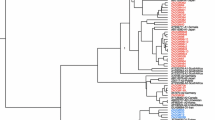Abstract
Background
Human hepatitis A, a widespread infectious disease that is hyperendemic in vast areas of the world, results in the infection of the liver. Different human HAV strains of diverse geographic origin are remarkably closely related. HAV exploits all known mechanisms of genetic variation to ensure survival, including mutation and genetic recombination.
Objectives
The aim of the study was to undertake an in-depth analysis of the mutation in three groups: (i) mild acute hepatitis (m-AH), (ii) severe acute hepatitis (s-AH), and (iii) fulminant hepatitis (FHF) A patients, who were tested positive for HAV RNA.
Materials and Methods
A total of 500 patients of acute viral hepatitis (AVH) were screened for HAV-IgM positivity from January 2003 to December 2004. HAV RNA positivity was subject to reverse transcription of RNA followed by polymerase chain reaction (RT-PCR) for the detection of HAV RNA. The HAV RNA positive cases were subject to single-stranded conformational polymorphism (SSCP).
Results
Out of 500 acute cases of hepatitis, 80 (16%) were positive for HAV-IgM. HAV RNA was detected in 34 (42.5%) cases by RT-PCR. Twenty-four (70.5%) were m-AH, seven (20.5%) were s-AH, and three (8.8%) were FHF. All the positive samples were subject to SSCP. No mobility shift was observed with respect to any screened samples by PCR-SSCP. Four (m-AHI-54, m-AHI-80, s-AHI-341 and FHFI-195 suspected cases were directly sequenced to prove that there was no point mutation.
Conclusion
SSCP demonstrates no mobility shift in the VP1/P2A region of the HAV genome. No point mutation was observed in the four suspected cases by sequencing. However a large study from different geographical locations is needed to achieve a logical conclusion about the existence of HAV mutation in the Indian population.


Similar content being viewed by others
References
Melnick JL (1982) Classification of hepatitis A virus as enterovirus type 72 and of hepatitis B virus as hepadnavirus type 1. Intervirology 18:105–106
Hadler SC (1991) Global impact of hepatitis A virus infection changing patterns. In: Hollinger FB, Lemon SM, Margolis HS (eds) Viral hepatitis and liver disease. Williams & Wilkins, Baltimore, MD, pp 14–20
Boelke E, Flehmig B (1995) New epidemiological patterns of hepatitis A and B infections in Germany. Zentralbl Hyg 196:511–514
Rosenblum LS, Mirkin IR, Allen DT, Safford S, Hadler SC (1990) A Multifocal outbreak of hepatitis A traced to commercially distributed lettuce. Am J Public Health 80:1075–1079
Desenclos JC, Klontz KC, Wilder MH, Nainan OV, Margolis HS, Gunn RA (1991) A multistate outbreak of hepatitis A caused by the consumption of raw oysters. Am J Public Health 81:1268–1272
Coulepis AG, Locarnini SA, Lehmann NI, Gust ID (1980) Detection of hepatitis A virus in feces of patients with naturally acquired infection. J Infect Dis 141:151–156
Feinstone SM, Kapikian AZ, Purcell RH (1973) Hepatitis A: detection by immune electron microscopy of a virus like antigen associated with acute illness. Science 182:182–184
Gust ID, Coulepis AG, Feinstone SM, Locarnini SA, Moritsugu Y, Najera R, Siegl G (1983) Taxonomic classification of hepatitis A virus. Intervirology 20:1–7
Weitz M, Baroudy BM, Maloy WL, Tichehurst JR, Purcell RH (1986) Detection of a genome-linked protein (VPg) of hepatitis A virus and its comparision with other picornaviral VPgs. J Virol 60:124–130
Cohen JI, Ticehurst JR, Purcell RH, Buckler-White A, Baroudy BM (1987) Complete nucleotide sequence of wild type hepatitis A virus: comparision with different strains of hepatitis A virus and other picornaviruses. J Virol 61:50–59
Jansen RW, Siegl G, Lemon SM (1990) Molecular epidemiology of human hepatitis A virus defined by an antigen-capture polymerase chain reaction method. Proc Natl Acad Sci USA 87:2867–2871
Tesar M, Pak I, Jia XY, Richards OC, Summers DF, Ehrenfeld E (1994) Expression of hepatitis A virus precursor protein P3 in vivo and in vitro: polyprotein processing of the 3CD cleavage site. Virology 198:524–533
Jia XY, Ehrenfeld E, Summers DF (1991) Proteolytic activity of hepatitis A virus 3C protein. J Virol 65:2595–2600
Robertson BH, Khanna B, Nainan OV, Margolis HS (1991) Epidemiologic patterns of wild-type hepatitis A virus determined by genetic variation. J infect Dis 163:286–292
Robertson BGH, Jansen RW, Khanna B et al (1992) Genetic relatedness of hepatitis A virus strains recovered from different geographical regions. J Gen Virol 173:1365–1377
Bruisten SM, van Steenbergen JE, Pijl AS, Niesters HGM, van Doornum GJJ, Coutinho RA (2001) Molecular epidemiology of hepatitis A virus in Amsterdam, the Netherlands. J Med Virol 63:88–95
Sambrook J, Russell DW. Molecular cloning: A Laboratory Manual. Cold Spring Harbor Laboratory Press; Cold Spring Harbor, New York, vol 2, 3rd edn 13.52
Suzanne U Emerson et al (1991) Mutations responsible for adaptation of Hepatitis A virus to efficient growth in cell cycle. Am Soc Microbiol 65:4882–4886
Shaffer DR, Lemon SM (1995) Temperature-sensitive hepatitis A virus mutants with deletions downstream of the first pyrimidines-rich tract of the 5′ nontranslated RNA is impaired in RNA synthesis. J Virol 69:6498–6506
Jansen RW, Newbold JE, Lemon SM (1988) Complete nucleotide sequence of a cell culture-adopted variant of Hepatitis A Virus: comparision with wild type virus with restricted capacity for in-vitro replication. Virology 163:299–307
Suzanne U, Emerson SU, Huang YK, Mcrill C, Lewis M, Purcell RH (1992) Mutations in both the 2B and 2C Gene of Hepatitis A virus are involved in adaptation to growth in cell culture. J Virol 66:650–654
Suzanne U, Emerson SU, Mcrill C, Robenblum B, Feinstone SM, Purcell RH (1991) Mutation responsible for adaptation of Hepatitis A virus to efficient growth in cell culture. J Virol 65:4882–4886
Suzanne U, Emerson SU, Huang YK, Purcell RH (1993) 2B and 2C mutation are essential but mutation throughout the genome of HAV contribute to adaptation to cell culture. Virology 194:475–480
Author information
Authors and Affiliations
Corresponding author
Rights and permissions
About this article
Cite this article
Hussain, Z., Husain, S.A., Pasha, S.T. et al. Does Mutation of Hepatitis A Virus Exist in North India?. Dig Dis Sci 53, 506–510 (2008). https://doi.org/10.1007/s10620-007-9870-9
Received:
Accepted:
Published:
Issue Date:
DOI: https://doi.org/10.1007/s10620-007-9870-9




